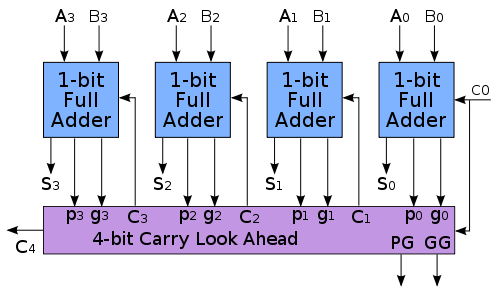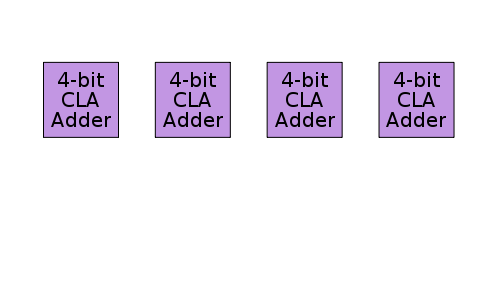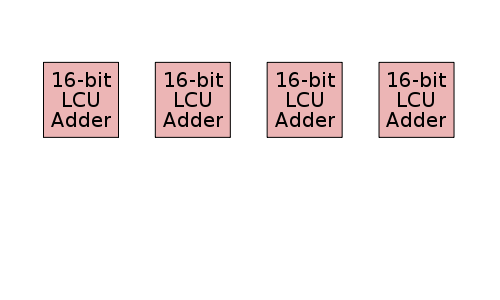
Lookahead Carry Unit
Encyclopedia
A Lookahead Carry Unit is a logical unit in digital circuit
design used to decrease calculation time in adder
units and used in conjunction with carry look-ahead adder
s (CLAs).

The LCU accepts the group propagate ( ) and group generate (
) and group generate ( ) from each of the four CLAs.
) from each of the four CLAs.  and
and  have the following expressions for each CLA adder:
have the following expressions for each CLA adder:


The LCU then generates the carry input for each CLA.
Assume that is
is  and
and  is
is  from the ith CLA then the output carry bits are
from the ith CLA then the output carry bits are




Substituting into
into  , then
, then  into
into  , then
, then  into
into  yields the expanded equations:
yields the expanded equations:




 corresponds to the carry input into the second CLA;
corresponds to the carry input into the second CLA;  to the third CLA;
to the third CLA;  to the fourth CLA; and
to the fourth CLA; and  to overflow carry bit.
to overflow carry bit.
In addition, the LCU can calculate its own propagate and generate:


Four of these units can be combined to form a 64-bit adder.
An additional (second-level) LCU is needed that accepts the propagate ( ) and generate (
) and generate ( ) from each LCU and the four carry outputs generated by the second-level LCU are fed into the first-level LCUs.
) from each LCU and the four carry outputs generated by the second-level LCU are fed into the first-level LCUs.

Digital circuit
Digital electronics represent signals by discrete bands of analog levels, rather than by a continuous range. All levels within a band represent the same signal state...
design used to decrease calculation time in adder
Adder (electronics)
In electronics, an adder or summer is a digital circuit that performs addition of numbers.In many computers and other kinds of processors, adders are used not only in the arithmetic logic unit, but also in other parts of the processor, where they are used to calculate addresses, table indices, and...
units and used in conjunction with carry look-ahead adder
Carry Look-Ahead Adder
A carry-lookahead adder is a type of adder used in digital logic. A carry-lookahead adder improves speed by reducing the amount of time required to determine carry bits...
s (CLAs).
4-bit adder
A single 4-bit CLA is shown below:
16-bit adder
By combining four 4-bit CLAs, a 16-bit adder can be created but additional logic is needed in the form of an LCU.The LCU accepts the group propagate (
 ) and group generate (
) and group generate ( ) from each of the four CLAs.
) from each of the four CLAs.  and
and  have the following expressions for each CLA adder:
have the following expressions for each CLA adder:

The LCU then generates the carry input for each CLA.
Assume that
 is
is  and
and  is
is  from the ith CLA then the output carry bits are
from the ith CLA then the output carry bits are



Substituting
 into
into  , then
, then  into
into  , then
, then  into
into  yields the expanded equations:
yields the expanded equations:



 corresponds to the carry input into the second CLA;
corresponds to the carry input into the second CLA;  to the third CLA;
to the third CLA;  to the fourth CLA; and
to the fourth CLA; and  to overflow carry bit.
to overflow carry bit.In addition, the LCU can calculate its own propagate and generate:



64-bit adder
By combining 4 CLAs and an LCU together creates a 16-bit adder.Four of these units can be combined to form a 64-bit adder.
An additional (second-level) LCU is needed that accepts the propagate (
 ) and generate (
) and generate ( ) from each LCU and the four carry outputs generated by the second-level LCU are fed into the first-level LCUs.
) from each LCU and the four carry outputs generated by the second-level LCU are fed into the first-level LCUs.

